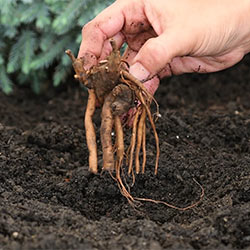No matter your preference of taste, Michigan Bulb is sure to have the rose plants that best suit your needs. You'll be surprised by the ease of gardening with our hybrid tea roses, floribundas, climbing roses, shrub roses, and much more!
These plants are shipped as rose roots, which should be planted in accordance with your designated growing zone. Growing zone information can be found on the product details page on each of our roses for sale.
Growing roses in your garden is easier than you think! For tips on how to care for roses, make sure to check out our rose tips and growing instructions. With their colorful varieties and beautiful blooms, roses make the perfect addition to any garden. Buy rose plants from Michigan Bulb today!
Types of Roses:
Climbing Roses: Climbing roses are perfect for covering walls, trellises, or archways, and they tend to perform in poorer-quality soil than other roses. To cover a wall or trellis located on pavement, some climbing roses can be planted in large planters. Just as exquisite as other rose forms, climbing roses may bloom in single or double varieties, and are available in a wide variety of colors. Some of our favorite climbers are hybrids of classic climbing roses and other varieties known for their heavy blooming. Climbing roses add a romantic and wild look to the garden, and make a great backdrop to your perennial garden.
Floribunda Roses: The term Floribunda comes from the Latin phrase meaning "many flowering." When it comes to big, bountiful blooms, Floribunda roses don't disappoint! These roses are a cross of polyantha roses and hybrid teas. Polyantha roses are a heavily-blooming rose type, while hybrid teas are considered classic for their elegant shape and sweet fragrance. The result is a high bloom yield of classic "rose-shaped" flowers. You'll get a bounty of flowers with Floribundas.
Grandiflora Roses: Just as Floribundas are hybrids of two types of roses, Grandiflora roses started by crossing Floribundas and large hybrid tea roses. Grandifloras tend to be larger-blooming and taller than Floribunda varieties, and feature multiple blooms per stem. Many Grandiflora roses grow in double, multi-layered forms jam packed with petals. They smell great, too!
Hybrid Tea Roses: Hybrid tea roses changed the gardening game in the early 1900s. For much of the 20th century, hybrid teas were considered to be the newest, hardiest varieties, and were much easier to grow than older rose varieties. Hybrid teas grow in a classic shape, and feature heavy, spicy-sweet fragrances. True classic stunners, hybrid teas are definitely here to stay.
Miniature Roses: Miniature roses are excellent for beginners! Plant mini roses in the garden or in containers on the patio. Miniature roses come from wild roses, and tend to be incredibly hardy and easy to take care of, with excellent disease resistance and a forgiving nature. Miniature roses also feature attractive blooms, and you'll find that they make excellent cut flowers.
Shrub Roses: Similarly to miniature roses, shrub roses are true easy-care species, way less particular even than unfussy hybrids and Floribundas. Use shrub roses as standalone species in the garden, or set them as hedge rows to delineate property lines or carve out a seating area. Shrub roses typically feature a ruffled, wide-open look, and bloom in a wide variety of colors. Some feature different colored "eyes" or centers.
Tree Roses: What are tree roses? Tree roses are man made varieties perfect for adding height and elevation to your garden. Tree roses are hybrid tea or floribunda roses grafted to a taller trunk to create dramatic height.
How do you prune roses?
To know how to prune your roses, you'll need to know what type of roses you're working with. Most modern roses, including Hybrid teas, Floribundas, and Grandifloras, bloom on "new wood," or a mix of "new wood" and "old wood." What does this mean?
Plants that bloom on new wood grow buds on the new growth that occurred since winter. When pruning, you don't need to keep wood from the last season, and can prune the plant back as much as you'd like.
Roses that bloom on old wood grow flowers on the growth from last season. If you prune too much, you'll leave only a bit of old growth-and you won't see as many flowers. These roses should only be pruned to remove dead wood, suckers, or damaged pieces.
Many roses bloom on a mix of new and old wood. For these plants, you should prune sparingly. Prune these roses to maintain a shape that you like, and leave a little of the old growth for maximum flower power.
Once you know how much of your roses to prune, you need to know when to prune. Most roses should be pruned in the very early spring, after the plant has begun to leaf out. The exception is roses that bloom on old wood, which should be pruned after blooming. Most roses you purchase from Michigan Bulb are newer, hardier, new-wood-blooming varieties, so you'll typically want to prune these roses in springtime. Check for a pink or red hue to your rose leaves -- that's when you know they're ready to prune.
Next, gather your tools. Long-handled shears are the best tool to get enough leverage to trim your rose bush, as scissors or small shears likely won't make the cuts cleanly. For truly tough canes, a saw may be the right tool. Most modern roses won't need commercially-available "wound care," as long as you make clean cuts. Make cuts at a 45 degree angle.
Prune with a careful eye to shape, and know your purpose and goal before taking the first cut. Take a step back and determine where you want to prune. Begin pruning from the ground up, starting with dead canes and crossed branches that chafe other canes. Next, remove any fresh growth that looks unhealthy or spindly. You should also remove "suckers" -- low, thin branches that "suck" energy from the plant.
While pruning can be a daunting task, you'll quickly get the hang of it. Don't worry if your first pruning job isn't picture-perfect, roses will grow back and you'll be rewarded with plenty of fresh flowers.
When should you plant roses?
Our roses are shipped in the spring, so that they can be planted while still dormant. Plant your roses as soon as possible after you receive them. That way, they'll have time to settle into their new home and build out some roots, before the summer hits and they need to put their energy producing foliage.
How much sun do roses need?
Most roses need six to eight hours of direct sunlight per day in order to produce their best flowers. Many roses can handle a bit of shade, sunlight that is indirect, or dappled sunlight, but may not bloom as brightly.
What type of soil is best for roses?
Loamy, well-draining soil is the best soil for roses. These plants suffer from wet, soggy roots, and drainage is important to prevent root rot and other issues. Roses prefer a slightly acidic environment, and most commercially-available rose amendments will provide the right pH. Compost is another good way to acidify the soil just the right amount.
Shrub roses and climbing roses can generally handle rocky or poor-quality soil a little better than other roses, but they still prefer a bit of enrichment with compost or peat moss.
How often should you water roses?
Roses are fairly thirsty perennials. Most varieties should be watered deeply twice per week, receiving an inch of water in each session. Of course, if your area is experiencing rainfall, Mother Nature takes care of the watering needs for you!
Water your roses early in the day, to avoid fungal issues or molds. Morning watering helps decrease the opportunity for mildew to set in, because the roses can dry out during the day before nightfall. Always water at the base of the plants, instead of the petals or leaves.
When should you fertilize roses?
Roses should be fertilized monthly during the growing season, starting when they begin to green in spring. Use a water-soluble fertilizer, preferably a balanced fertilizer or one geared toward roses. Alfalfa meal, bone meal, or compost are great natural options for fertilizing your roses, too. And, many gardeners swear by adding coffee grounds to the soil around their roses!

























